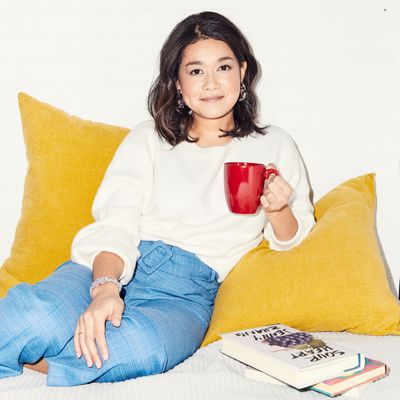
The Cut is asking readers to share what they’re doing with their money — or the lack of it — in the midst of an unprecedented crisis. This week we spoke to Alisha Ramos, who founded the weekly newsletter Girls Night In as a side hustle back in 2017. Initially, it was her outlet to cope with an increasingly frustrating government job and the isolation that came with it. But the concept took off so quickly that she was able to quit her day job and, two years later, raise half a million dollars in VC funding. Then the pandemic hit, and she found herself in a strange position: How do you run a company about the pleasures of staying in, when millions of people wish they didn’t have to?
I’m curious how it feels to be one of the few companies that’s actually doing well in the pandemic. It must be sort of surreal, and not necessarily in a good way.
It’s been awkward. I was getting texts from friends and family saying, “Wow, this is such a great time for Girls Night In, because everyone is staying in!” And it was like, well, yes, we’re all staying in, but Girls Night In is about staying in as a choice, and for a joyful reason. Not because we have to stay in to survive and to save other people’s lives.
But it’s true that we have seen a big bump in readership. And that was a little bit uncomfortable, because it’s not a time to celebrate anything. Internally, it was tough to find our footing, as a team. What does it mean to be a company about staying in when everyone is staying in to survive? I think we did handle the messaging in a thoughtful way. Usually, the tone of our newsletter is very joyful and lighthearted, but there were many times in the past few months when that tone would have been completely inappropriate.
So, how well are things actually going?
At the beginning of all this, in March, we were actually pretty scared. Our business model relies heavily on advertising revenue, particularly from consumer brands, and a lot of forecasting showed a big decline there. Originally, we had very aggressive revenue growth goals this year, especially from advertisers, but I immediately decreased our revenue goal for Q2 by 25 percent. I also had to pause hiring new full-time staff like I’d planned. Luckily, we were able to avoid layoffs. Our team is seven people full-time.
Then, around April and May, something weird happened. We actually surpassed not only our decreased advertising revenue goal, but also our original revenue goal by about 30 percent. I feel weird sharing that, to be honest, because so many other businesses are struggling. I couldn’t believe it myself. I was like, “We have to re-check these numbers.” I’m still almost waiting for the other shoe to drop, because as we’ve seen, things can shift so quickly. But now we’re on track to double our annual revenue this year.
What have your readers been responding to? It’s a really strange time to sell things, but that doesn’t mean people stop wanting them.
We had to meet readers where they were, and at first, they were scared and overwhelmed and feeling helpless. Many of our readers still feel that way. So we launched this project called Stay Home Take Care, with different sections focused on different needs. We had sections like, “I want to be entertained,” or “I want to be comforted,” or “I want to help other people,” or “I have kids at home and I need to gain some sense of normalcy.” It drew about over 100,000 visits in its first few days, and it’s been really successful.
Now, our readers are gravitating toward more utilitarian recommendations. For example, I recently recommended this little milk frother that I’m using for my coffee every day, and people really liked that. Relatively inexpensive items that serve a function in this new normal are doing well. Then, of course, there are the categories that you might expect people to really want right now, like loungewear. We’ve been getting a ton of requests for house dresses, which is a category I wasn’t even familiar with before.
How exactly does your business make money?
The first and most significant source of revenue is brand partnerships and sponsored content in our weekly newsletters. We’ve worked with Netflix, Brooklinen, a lot of direct-to-consumer brands that you typically might see advertising on Instagram. The second revenue stream is affiliate marketing, where we recommend products and get a cut of that sale. That’s been the fastest growing revenue stream for us. Our readers seem to trust what we recommend, and we put a lot of work into keeping that trust.
And then the third revenue stream, which we just officially launched last week, is subscription memberships to the Lounge, which is our new membership community platform built for online and offline gatherings. The original idea was for our members to be able to host small gatherings in their homes for book clubs and things like that. We were planning to launch it officially in April, but the pandemic obviously made the concept unworkable. So we overhauled everything. All of our gatherings are now virtual. We have a partner perks program, where members get discounts to brands. We have a Slack space where members can chat.
I often see Girls Night In described as a “self-care” brand, and I’m curious how you feel about that term, especially now that we’re in a global health crisis.
When I first started Girls Night In, I actually never used the term “self care.” It was slapped on by other people because they were like, “Oh, a night in. You’re taking care of yourself. Self care.” There was a period of time where we embraced that, but now the term is very complicated when so many people are hurting. Self care isn’t selfish, but it also shouldn’t be the end goal. It should be the means to an end. For us, the end point is taking care of other people and the community. Community care is also self care. That’s why I started this whole company in the first place. My intention was never to create a media brand. Instead, I was trying to solve a problem in my life of not knowing how to make new friends in a normal, not awkward way. I didn’t know how to build a community. And that’s how the idea for the Lounge came about. Now, in the midst of the Black Lives Matter movement and the pandemic, community care is more important than ever before. A lot of it comes down to individuals asking themselves and each other, “What can I do in my personal time to take care of people in my community who are not getting the care and resources that they deserve?”
I read that you saved up $20,000 before you quit your full-time job in 2017. How did you do that, and what made you decide that you were ready to be a full-time entrepreneur?
It was complicated. I had saved up $20,000, and that was my life savings — it’s what I’d gradually put away since the start of my professional career in 2012. So it took me almost five years to save that, and it was my only safety net, which was scary. I could not ever lean on my parents for financial support of any kind. So leaving my job was a difficult decision. At the time, I was working on Healthcare.gov as a design lead. I was supposed to help reimagine the consumer experience of that. Then the election happened, and I hit this wall of burnout. The problem wasn’t that I was working too hard, but that I was working so hard on something that could no longer be completed because [federal health care] policies were shifting and staff was turning over. And at that point, Girls Night In was a fun side project, but it was also starting to grow and take up more of my attention. I was getting emails from strangers about how much they loved it. Subscriber numbers were skyrocketing, and it was generating some revenue. At that time, I think I was selling ads for a little less than $500 per newsletter. So I thought, if not now, when am I ever going to do this? If it doesn’t work out in the next six months, I figured I’d go back to working in tech. So I also had a plan B.
What does a night in look like for you right now?
It probably doesn’t differ that much from other people’s. I watch a lot of shows — I just watched The Babysitter’s Club with my fiancé, and we both loved it. We cook a lot. Because of the newsletter, people always seem to think I take baths all the time, but I almost never do. I think I took one bath all of last year. But last week, after we launched The Lounge, I basically locked myself in the bathroom, turned off all the lights, lit a candle and drew a bath. I don’t know why I don’t do that more often. It’s awesome. I was like, “Nobody talk to me. Nobody touch me. This is my me-time.”





